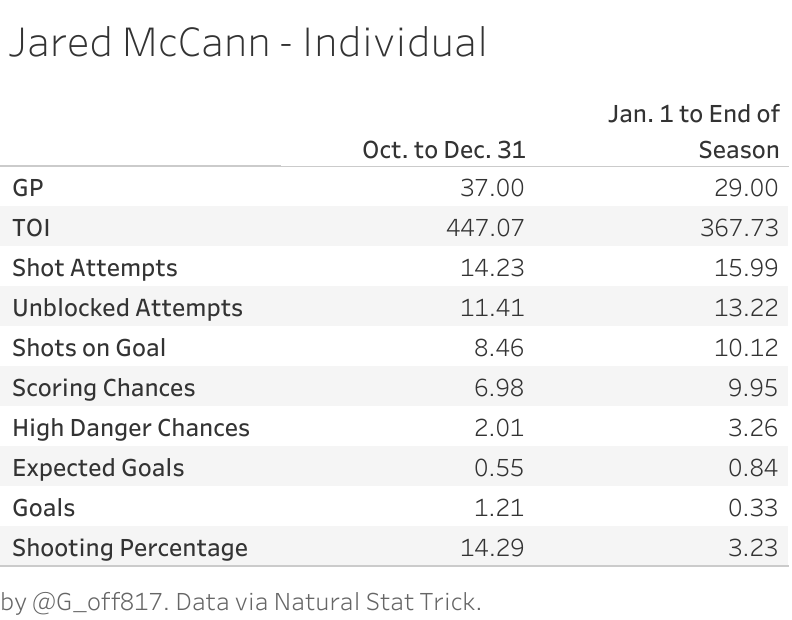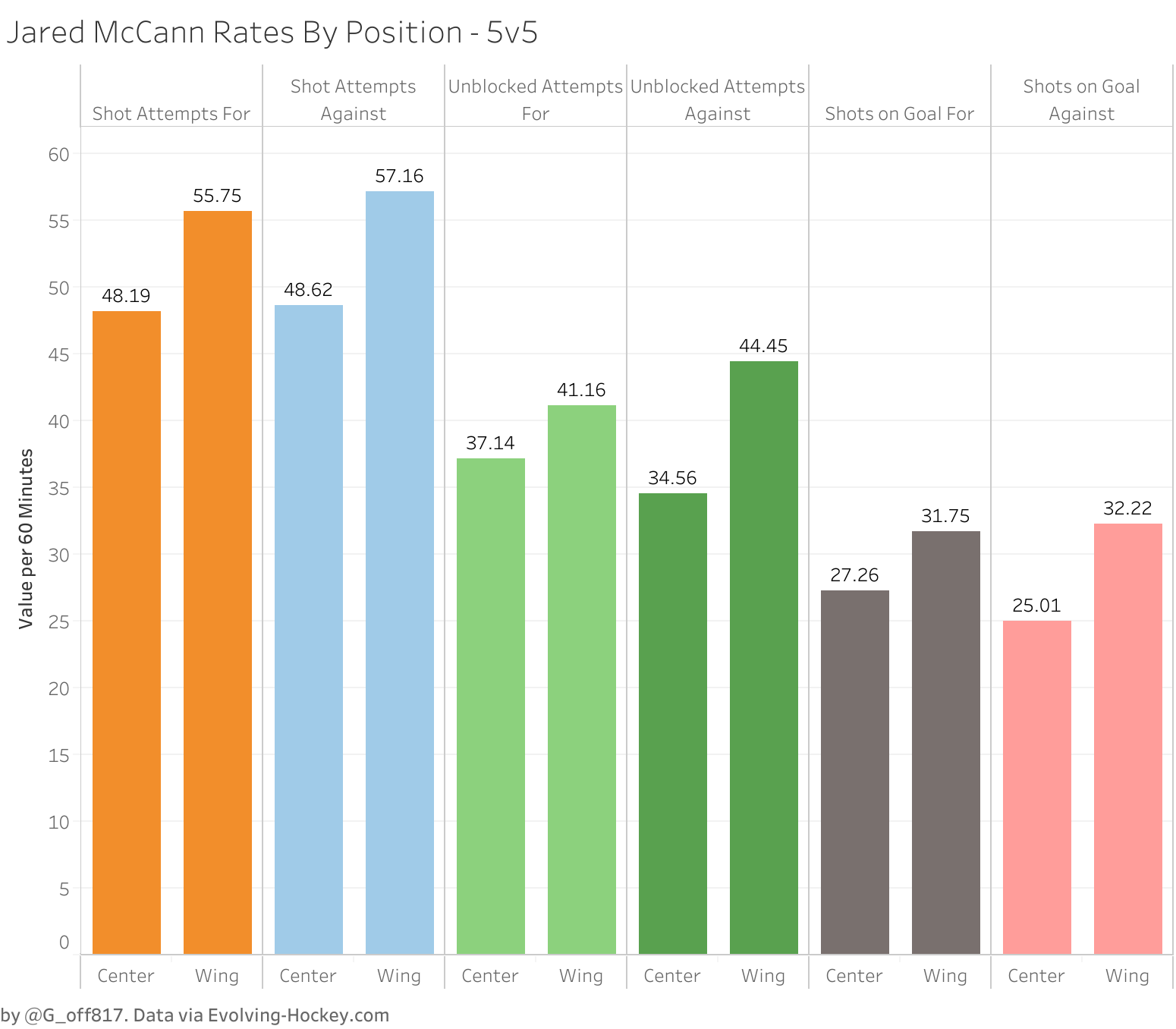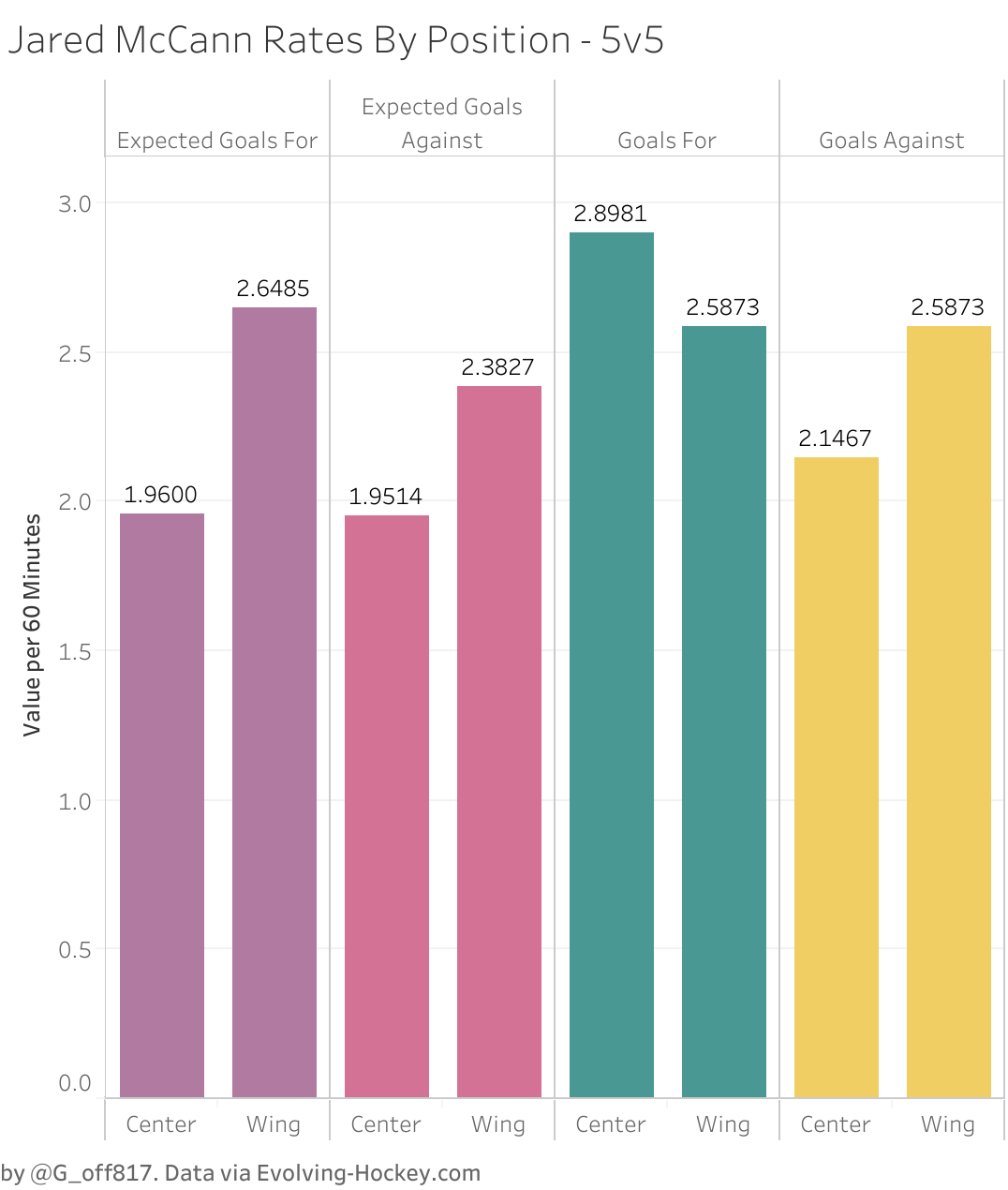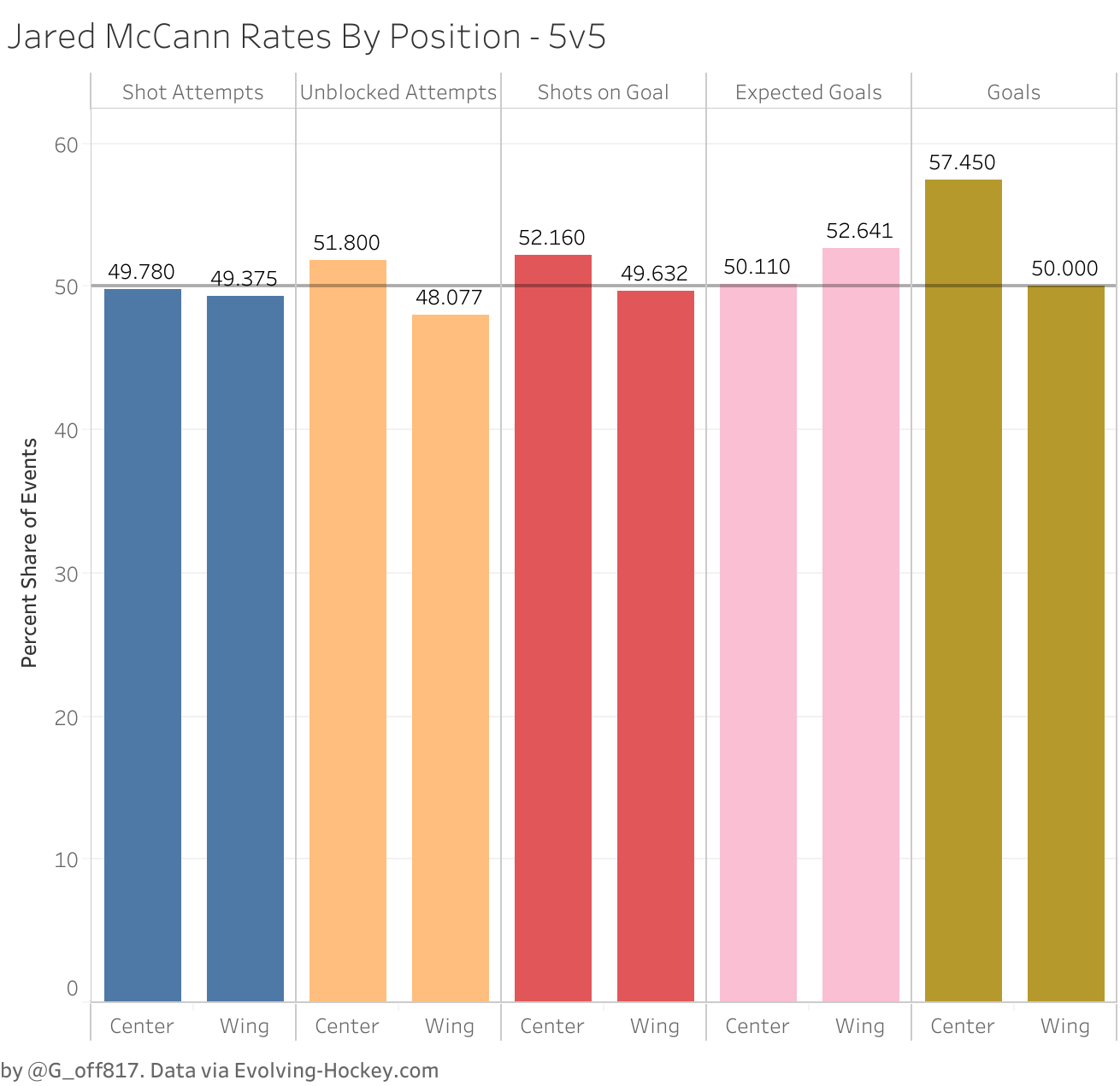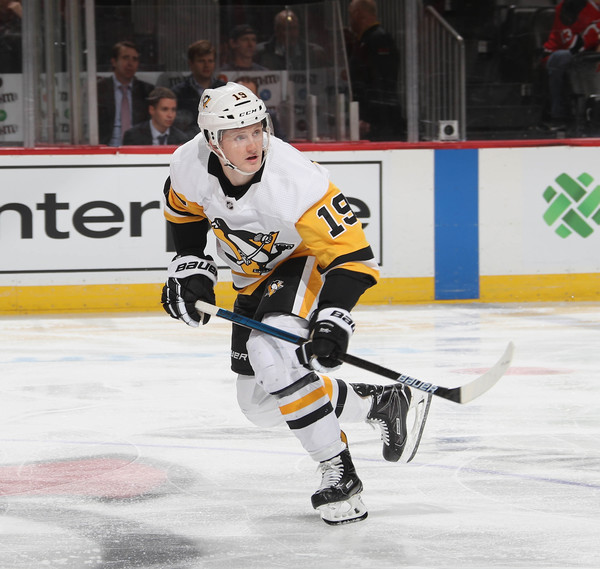
After 3 poor games with a healthy scratch sandwiched in there in what was overall an organization-wide, damningly horrific display of a sorry excuse for playoff hockey, the focus has predictably shifted towards the offseason and, in this case, what to do with Jared McCann.
McCann’s 3 games in the postseason left a lot to be desired for a player who had high expectations of blossoming into the 3rd line center that the Penguins never really replaced in Nick Bonino or, if you’re feeling frisky, Jordan Staal.
McCann hit the ground running in Pittsburgh immediately after the trade that brought him (and Nick Bjugstad) to town from Florida, scoring 11 goals in 32 games in all situations.
Conventional wisdom knew that was never going to be sustainable or replicated, whether it be because he converted on 15.3% of the shots he took (versus a career average of 8.8%) or because 4 of the 11 were scored into an empty net and 3 of the 11 came shorthanded.
But, rightly or wrongly, the narrative and expectation was set that he was going to be a goalscorer.
Those expectations are probably why we’re having this conversation today. At least partially.
Because, on one hand, despite scoring 14 goals across 66 games this year, he accumulated 0 in 25 games and saw his shooting percentage come back down to a more reasonable 9.3%. That tally of 14 goals, incidentally, is a career high for McCann.
As a side note, there’s a belief that McCann shot the puck less or otherwise passed up on opportunities when the calendar turned to 2020, but as it turns out, that wasn’t the case.
At 5-on-5, adjusting per 60 minutes of play, via Natural Stat Trick:
In fact, McCann himself attempted 1.76 more shots (1.81 more unblocked), 1.66 more shots on goal, generated nearly 3 more scoring chances (1.25 more high danger), and 0.29 more expected goals per hour of 5v5 play from January 1 onward. But the idea that he shot the puck less may simply be attributed to his shooting percentage dropping from 14.29% in the 2019 portion of this season to 3.23% in the 2020 portion. That may also be why McCann is even a topic of discussion right now.
Now, on the other hand (remember the first hand?), a 3 game, 16+ minute sample size where his line with Marleau and Hornqvist got hammered at 5v5 to the tune of an expected goals share of just 35.56%. Whether via the eye test or the data, those 3 were bad and McCann is at least partially culpable.
During McCann’s 104 games with the Penguins, including playoffs, we’ve seen him play on the left wing on all 4 lines and play center on lines 2, 3, and 4. This season alone, he saw the bulk of his time as 1LW, 2LW, and 3C because of injuries and his versatility. On those 3 lines alone, he saw more than 30 minutes with 9 different teammates and no more than 84 minutes with a consistent line combination.
That’s a lot of bouncing around.
On top of that, he’s just 24. He’s still learning the game, learning what his best position is, and learning where to be on the ice in various situations.
It benefits no one – not McCann, not the Penguins, not Sullivan, not Rutherford, and certainly not anyone writing about this silly sport – to bounce a young player around like this, whether out of necessity or to try to spark something, when trying to discern where exactly he should play in the lineup.
But in the first 1.5-2 months of the season, McCann did get a solid run playing in that third line center role for the Penguins. The results were outstanding. From a post I wrote back in mid-November:
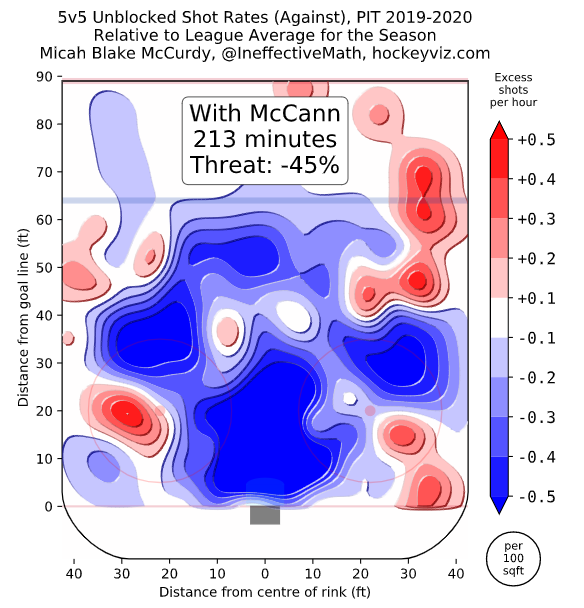
“While the Penguins have generated more unblocked shot attempts (4.62), scoring chances (1.74), high danger chances (2.15), and expected goals (0.23) with McCann off the ice per hour of play, it’s the suppression game where he’s shined.
With McCann on the ice, the Penguins are giving up less of everything across the board compared to when he’s off of it. They and he have been blanketing teams.
And that overwhelming defensive approach pays dividends in the end. The Penguins smother teams, coming out with a +4.11% share of unblocked attempts, +5.02% share of scoring chances, +7.97% share of high danger chances, and +8.42% share of the expected goals with McCann on the ice.
In other words, with McCann on the ice, the Penguins are dominating play this season at 5v5.”
Of course, the game isn’t played in just the first two months of the season and the conversation still harkens back to whether McCann is a middle 6 left wing or a center on this team.
So let’s take a look at that, shall we?
At 5-on-5 this season, McCann played roughly 559 minutes at center (i.e. ice time not spent with Crosby, Malkin, or Blueger) and approximately 255 on the wing.
The first two graphs below show his shot rates per hour of 5v5 play (top) and expected/actual goal rates (bottom).
What we can see here is that, with the exception of actual goals scored, the Penguins with McCann on the wing were a much higher event team at both ends of the ice. You would expect that given that McCann, when on the wing, is usually playing with the likes of Malkin and Crosby versus playing (third line) center, where you would expect a more defensive, low event approach to the game.
For a third line center on a top heavy team like the Penguins, the low event play is fine at a minimum and great in a perfect world.
Moreover, and perhaps more importantly, the on-ice suppression results for McCann at center speak for themselves. The less attempts, shots, and expected goals allowed, the better.
We can conceptualize this in the overall share of events that take place with McCann on the ice in both positions, illustrated below.
With the exception of the share of expected goals, the Penguins find themselves controlling more of the events taking place with McCann at center than at wing. In fact, only in the share of shot attempts does McCann’s body of work fall below the 50% threshold when playing center.
To that end, with McCann on the wing this year at 5v5, the Penguins actually gave up more shot attempts, unblocked attempts, and shots on goal than they generated. They scored as many goals as they gave up, while the 2.65 expected goals for at wing really pushes that overall share up.
Now, the point here isn’t to make any determination on where McCann should be playing. Rather, the point here is to make clear that there is evidence to suggest he can play in the 3C hole, which has been largely reported as the reason they went out and got him in the first place.
But with the evidence being there, we have to consider the differing styles of play. If you want low event, responsible defense instead of higher event, attacking-focused play, you probably want to see McCann at center. But if you want another speedy winger and to go out and try to find yet another 3C, you probably want to see McCann at wing.
For Jim Rutherford, Mike Sullivan, and the Penguins, the key to really knowing if McCann is the Heir to the 3C Throne is to give him an extended run in that position next season.
Otherwise, the decision to move him to the wing or move him off the team will seemingly be based off less than 20 minutes of 35.56% expected goal play that appears to be the outlier compared to everything else he’s done to this point in this season, let alone his entire career.
The solution may be as simple as giving him a bridge deal this offseason and letting him play the entirety of the 2020-21 season (whenever that may start) as a center to fully learn and grow into the position (and let him go through the growing pains). With Guentzel and now Zucker in the top 6, Rodrigues and Tanev in the bottom 6, the necessity or desire to bump him to the wing should subside significantly.
Simply put- deal with whatever growing pains there may be, then reassess in a year’s time.
Add The Sports Daily to your Google News Feed!

